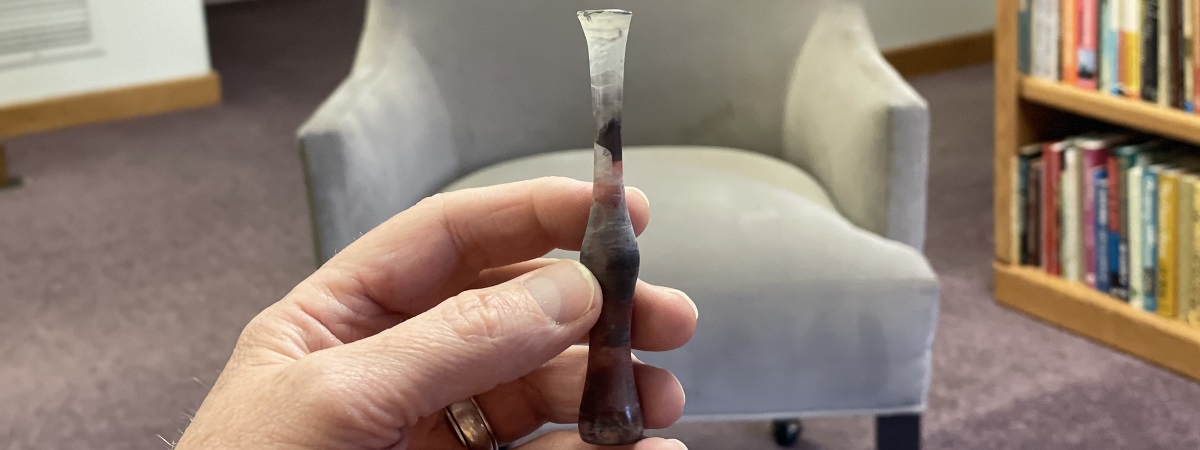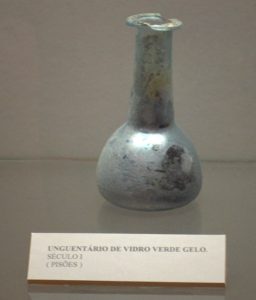
I heard about tear bottles on my first trip to Israel. I brought home a dozen with a simple idea in mind, and I’ve kept a stock of them ever since. What an amazing little help they have been.
What are tear bottles? Also known as tear vials or tear catchers, the technical term is “lachrymatory bottles”. Used for thousands of years, they have been found in tombs throughout the Near East and Mediterranean; small bottles to catch a grieving persons tears as a memorial and sign of devotion.
We were in the Christian quarter of the old city of Jerusalem, and my friend, Dr. Paul Conway, said he needed a few minutes in a little shop down one of the many alleyways. As we entered, the shop owners greeted him as an old friend and, in Near Eastern fashion, immediately sat us down and brought thick black coffee.
Paul told them he needed more tear bottles. They brought out big boxes full of the small blown glass vials of every color. Paul began rummaging through, selecting the ones he liked and wrapping them in newspaper for the journey home. He began to tell me what he wanted them for. When I heard the idea, I started wrapping some for myself.
Table of Contents
A Quick History of Tear Bottles

Photo by Georges Jansoone / CC BY-SA 3.0
Tear bottles, or lachrymatory, have been discovered in excavated near eastern tombs going back more than 3,000 years. The Romans and Greeks also had similar customs, filling small glass vials or cups. In those cultures, “professional mourners” were sometimes paid to cry into tear bottles as they walked along wailing in the funeral procession.
There’s quite a lot of controversy, but some say that tear bottles reappeared in England during the Victorian Era of the 19th century. (The Victorians certainly did have a morbid fascination with grieving and grieving rituals.) At this time they were called “tear catchers”; and when the tears in the bottle evaporated, the time of mourning could be ended.
As I said, this is greatly disputed. Some claim that the Victorian story was invented in recent years just to sell tear bottles, because there is now a hot market for all things Victorian. That’s very possibly true, but it does not have anything to do with the ancient custom of the near east, which is well-attested.
Tear Bottles in the Bible
Maybe you’ve read this verse many times, but didn’t know the ancient custom behind it …
“You number my wanderings; Put my tears into Your bottle; Are they not in Your book?” Psalm 56:8
King David seems to be referring to a tear bottle. He imagines that God has one for all of our tears, as well as a book of all the days that we live. In other words, God is not removed; He is not distant and unconcerned. He notices every small detail of our lives, and He shares in our grief.
There’s another scene in the Bible. in Luke 7:37-38. It’s the story of a woman who brought an alabaster box of fragrant oil, and she washed Jesus’ feet with tears, and then anointed them with the oil.
Some scholars have suggested that this may be another reference to a tear bottle. That perhaps she had collected all the tears of a long grief, but poured them out that day because she had found her healing in Jesus.
A Simple Idea for Ministry Today
So, back to my friend, Paul.
Sat in the little shop in Jerusalem that day, he told me how he used these little bottles. You can buy them in Jerusalem for just a couple of dollars each. He would bring them home, and every time he had a funeral he would give them to the grieving loved ones. He would share Psalm 56 with them, and assure them that God was with them in their mourning. That He has a bottle.
Now, let me assure you, Paul does not offer them as some superstitious amulet. Rather, they are a simple reminder of a precious promise in Scripture.
I came back from Israel with a dozen tear bottles in my case.
My First Experience
A short while later I ministered at the funeral for a relatively young man in our congregation who had died suddenly, leaving a wife and seven children. That’s a tough funeral. A tear bottle wasn’t going to fix everything, but I took the Psalm as my text and preached “God Has a Bottle and a Book”. I held up the tear bottle for everyone to see, and it somehow brought the text to life.
After the service I gave that tear bottle to the man’s wife. She said thank you, and slipped it in her pocket. On the following Sunday, she spoke to me after church and asked if there was any way she could get one for all of her children. I, of course, went and raided my small stash.
I’ve returned to Israel again since that first trip, and I made sure to include a visit to the little shop in the Christian quarter. This time I bought several dozen, and I’ve used them at most funerals since. I don’t always preach the same text. Sometimes I just share it privately with the family. But it always has an impact.
I talk a lot on this blog about “tactile ministry”. In a world where everything is bits and bytes, and moves at a frenetic pace, people crave the personal, the real, the tangible – and especially when they are going through a hard time. This is just another small way to do it.
Where to Get Tear Bottles
If you’re ever in Israel, there’s actually quite a few shops that sell them and they’re very cheap. It’s kind of nice to be able to say to the people you give them to, “I picked this up in old Jerusalem when I was there.”
 But if that’s not practical, you can buy them online. They come in a whole range of designs. Just don’t fall for a huckster – there are sites selling antique perfume bottles as tear bottles for $30 to $50 each.
But if that’s not practical, you can buy them online. They come in a whole range of designs. Just don’t fall for a huckster – there are sites selling antique perfume bottles as tear bottles for $30 to $50 each.
Check Amazon with the search term “lachrymatory tear bottles”. You’ll get a bunch of results, and I suggest you choose a simple design rather than something gaudy or elaborate. It’s not important that the bottles be “authentic” or old. They are a simple reminder, that’s all.
If you DO use them, stop back at this post and leave a comment. Tell us how it went.
Ever since I got a couple of books on manners and customs of Bible times, it has really changed how I read Scripture. Many things that sounded completely allegorical were actually based on real happenings, like the hot coals on the head reference in Romans. I did not know that tear bottles were an actual thing and not just symbolism. That’s good to know. Thank you for that information.
It’s fascinating, isn’t it. I’m about half way through completing a Master’s program in Archaeology and Biblical history. The thing I’m loving the most is learning all the little cultural insights that shed a whole new light on the text.
I have 5 sympathy cards to send right now, which is unusual for me. I just ordered some bottles and envelopes to send them. This will add a touch of care to these dear hurting friends. Thank you for the idea.
I’m sure they were a great blessing, Sue.
Phil
I stumbled upon your article and I must say I could not agree more. The attention to detail is great when reading the bible. I am studying the Hyssop tree ( Psalms 51:7) and am curious as to the connection/ use of the Hyssop tree for us today. Also, ordering my bottles in a few days…
K. P.
That’s great, Klent. Last time my wife and I were in Israel, we brought back some ground hyssop and local olive oil. The hyssop has a unique taste, and when you spread the oil on crusty bread with a sprinkle of hyssop, it’s delicious. However, I understand that hyssop was also used as a cleaning agent – hence the reference in Psalm 51.
Phil
I am a facilitator in a local meeting of a well known Christian grief support group. ( GriefShare). I started putting together bottles with glass tear shaped beads, and a bookmark with Psalm 56:8, and a paragraph about the meaning of that verse adapted from www. GotQuestions.org. I hand these to participants at their first meeting, along with talking to them about the significance of the verse. In my experience, this has meant so much to the participants. I do this for the reason you mentioned in your article, to give them a physical reminder that our God loves them, sees their grief, grieves along side them, and is there to be with them as they heal.
What a wonderful idea, Karolee. Thanks for sharing it!
God bless your vital ministry to the grieving. Phil
Very insightful information.
Thank you for sharing.
You’re welcome, Johnny. Thanks for your comment.
Phil
Thank you for this article. I’m studying to teach on Luke 7 at a women’s retreat and this article helped to shed light and add depth to that passage.
That’s wonderful, Carole. I pray you’ll be a great blessing to those women.
Phil